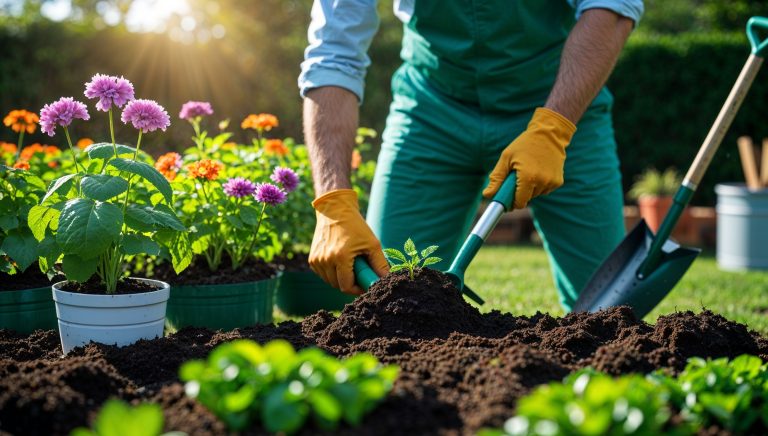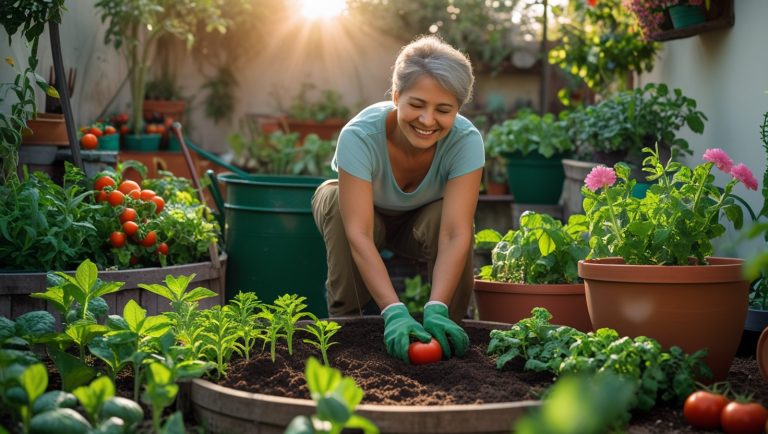

Before diving into buying plants and tools, the first step in how to start a garden at home is evaluating the space you have. This might seem simple, but taking the time to assess your environment will help you make more informed decisions. Consider factors such as sunlight, soil type, and available space to create a garden that thrives.
One of the most crucial factors when figuring out how to start a garden at home is determining how much sunlight the area receives. Some plants thrive in direct sunlight, while others prefer the shade. Spend a day or two observing how sunlight hits your garden area to determine which plants will do best in each spot. For example, sun-loving plants like tomatoes or peppers will need at least 6-8 hours of direct sunlight each day, whereas shade-loving plants like ferns or hostas can flourish with less light.
Knowing what kind of soil you have is essential when figuring out how to start a garden at home. The soil composition determines how well plants will grow. Test your soil’s texture and pH. If your soil is sandy, it drains too quickly, and if it’s clay-heavy, it may retain too much water. The ideal garden soil is a balanced loam that holds moisture but also drains well. You can amend your soil with compost or organic matter to improve its structure and fertility.
Once you’ve assessed your space and soil, the next step in how to start a garden at home is choosing the plants that will thrive in your environment. Not all plants are suitable for every garden, and selecting the right ones will ensure a healthier, more vibrant garden. Start by considering the climate, the amount of sunlight, and the space you have available.
For beginners, choosing low-maintenance plants is key to success. Some of the easiest plants to grow at home include succulents, herbs, and perennial flowers. Succulents like aloe and jade plants require minimal watering and thrive in sunny spots. Herbs such as basil, thyme, and rosemary are perfect for small garden spaces or even container gardens. These plants are not only practical for cooking but also easy to care for. If you’re looking for colorful flowers, perennial flowers like lavender and coneflowers are great options as they come back year after year.
Another important aspect of how to start a garden at home is understanding the growing seasons of the plants you choose. Some plants thrive in the warmer months, while others are better suited for cooler weather. If you’re in a region with cold winters, you may want to focus on annuals or frost-resistant plants. For year-round enjoyment, incorporate evergreen shrubs or trees that retain their foliage even during the colder months.
With your plants chosen, the next step is preparing your garden area. Proper preparation is essential for creating a healthy and productive garden. This involves clearing the space, enriching the soil, and making sure everything is ready for planting.
Start by removing any weeds, grass, or debris from your garden space. These can compete with your plants for nutrients, water, and sunlight. For larger garden areas, a hoe or rake can help clear the soil efficiently. If you’re working in a container or raised bed, simply remove any unwanted items and ensure the space is clean and ready for planting.
As mentioned earlier, soil quality is crucial for plant health. To improve soil texture and fertility, mix in compost, organic fertilizers, or other soil amendments. Compost provides essential nutrients that plants need to grow strong roots and vibrant foliage. Be sure to mix these amendments thoroughly into the top few inches of soil to create an optimal growing environment.
To ensure that your garden thrives, it’s important to use the right tools. Having the right gardening tools can make tasks like planting, watering, and pruning much easier. You don’t need a huge collection, but a few essentials will help you along the way.
Some of the most important tools to have when learning how to start a garden at home include a trowel, a watering can, pruning shears, and gloves. A trowel is perfect for digging small holes for planting and is especially useful for container gardens. A watering can or garden hose ensures that your plants receive the right amount of water without overwatering. Pruning shears will help you trim dead growth and keep your plants healthy. Finally, a good pair of gardening gloves will protect your hands while you work.
One of the key aspects of how to start a garden at home is making sure that your plants receive the right amount of water. Over or under-watering can be detrimental to plant health, so it’s important to establish a watering routine.
Watering needs will vary based on the plants you choose and the climate in your area. Some plants require consistent moisture, while others prefer to dry out between waterings. For most plants, watering deeply once a week is better than frequent shallow waterings. If your garden is in a hot, sunny area, you may need to water more often, especially during dry spells.
Ongoing maintenance is necessary to keep your garden healthy and vibrant. Regularly check for weeds, pests, and diseases. Pruning dead or diseased growth will promote better airflow and prevent the spread of disease. Additionally, mulching around your plants can help retain moisture, suppress weeds, and keep the soil temperature stable.
Even the most experienced gardeners face challenges, and knowing how to troubleshoot common problems is part of how to start a garden at home. Whether it’s pests, diseases, or weather-related issues, being prepared can help you overcome these obstacles.
Pests are a common issue for gardeners, but they can usually be managed with natural remedies. Insects like aphids, slugs, and caterpillars can damage your plants, but simple solutions like neem oil or insecticidal soap can help deter them. For larger pests like rabbits or deer, consider installing barriers or using organic deterrents.
Fungal and bacterial diseases can affect your plants if not properly managed. To reduce the risk of disease, make sure your plants are spaced adequately for airflow. Water the base of the plants, rather than the leaves, to avoid creating a damp environment that encourages mold and mildew. If you notice yellowing or spotted leaves, remove them promptly to prevent the spread of disease.
Finally, remember that gardening is a journey, not a race. One of the most important parts of how to start a garden at home is to enjoy the process. Gardening is an ongoing learning experience, and every season offers new challenges and rewards.
Gardens take time to grow, and not everything will be perfect right away. Don’t be discouraged if your plants don’t bloom immediately or if things don’t go as planned. With patience and persistence, you’ll see your efforts pay off. Celebrate the small wins, whether it’s the first bloom or the growth of your first vegetable.